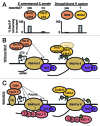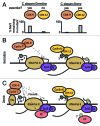RNA polymerase II transcription elongation and Pol II CTD Ser2 phosphorylation: A tail of two kinases
- PMID: 24879308
- PMCID: PMC4133218
- DOI: 10.4161/nucl.29347
RNA polymerase II transcription elongation and Pol II CTD Ser2 phosphorylation: A tail of two kinases
Abstract
The transition between initiation and productive elongation during RNA Polymerase II (Pol II) transcription is a well-appreciated point of regulation across many eukaryotes. Elongating Pol II is modified by phosphorylation of serine 2 (Ser2) on its carboxy terminal domain (CTD) by two kinases, Bur1/Ctk1 in yeast and Cdk9/Cdk12 in metazoans. Here, we discuss the roles and regulation of these kinases and their relationship to Pol II elongation control, and focus on recent data from work in C. elegans that point out gaps in our current understand of transcription elongation.
Keywords: Bur1; C. elegans; Cdk12; Cdk9; Ctk1; P-TEFb; RNA Polymerase II; Serine 2; elongation; transcription.
Figures


Similar articles
-
Phosphorylation of the Pol II CTD by KIN28 enhances BUR1/BUR2 recruitment and Ser2 CTD phosphorylation near promoters.Mol Cell. 2009 Mar 27;33(6):752-62. doi: 10.1016/j.molcel.2009.02.018. Mol Cell. 2009. PMID: 19328068 Free PMC article.
-
CDK12 is a transcription elongation-associated CTD kinase, the metazoan ortholog of yeast Ctk1.Genes Dev. 2010 Oct 15;24(20):2303-16. doi: 10.1101/gad.1968210. Genes Dev. 2010. PMID: 20952539 Free PMC article.
-
CDK12 globally stimulates RNA polymerase II transcription elongation and carboxyl-terminal domain phosphorylation.Nucleic Acids Res. 2020 Aug 20;48(14):7712-7727. doi: 10.1093/nar/gkaa514. Nucleic Acids Res. 2020. PMID: 32805052 Free PMC article.
-
CDK9 keeps RNA polymerase II on track.Cell Mol Life Sci. 2021 Jul;78(14):5543-5567. doi: 10.1007/s00018-021-03878-8. Epub 2021 Jun 19. Cell Mol Life Sci. 2021. PMID: 34146121 Free PMC article. Review.
-
Control of RNA polymerase II activity by dedicated CTD kinases and phosphatases.Front Biosci. 2001 Oct 1;6:D1358-68. doi: 10.2741/majello. Front Biosci. 2001. PMID: 11578967 Review.
Cited by
-
1,10-phenanthroline inhibits sumoylation and reveals that yeast SUMO modifications are highly transient.EMBO Rep. 2024 Jan;25(1):68-81. doi: 10.1038/s44319-023-00010-8. Epub 2024 Jan 5. EMBO Rep. 2024. PMID: 38182817 Free PMC article.
-
A SUMO-dependent pathway controls elongating RNA Polymerase II upon UV-induced damage.Sci Rep. 2019 Nov 29;9(1):17914. doi: 10.1038/s41598-019-54027-y. Sci Rep. 2019. PMID: 31784551 Free PMC article.
-
DSIF modulates RNA polymerase II occupancy according to template G + C content.NAR Genom Bioinform. 2022 Jul 27;4(3):lqac054. doi: 10.1093/nargab/lqac054. eCollection 2022 Sep. NAR Genom Bioinform. 2022. PMID: 35910045 Free PMC article.
-
Key Players in HIV-1 Transcriptional Regulation: Targets for a Functional Cure.Viruses. 2020 May 11;12(5):529. doi: 10.3390/v12050529. Viruses. 2020. PMID: 32403278 Free PMC article. Review.
-
Deciphering the Epigenetic Code in Embryonic and Dental Pulp Stem Cells.Yale J Biol Med. 2016 Dec 23;89(4):539-563. eCollection 2016 Dec. Yale J Biol Med. 2016. PMID: 28018144 Free PMC article. Review.
References
-
- Cadena DL, Dahmus ME. Messenger RNA synthesis in mammalian cells is catalyzed by the phosphorylated form of RNA polymerase II. J Biol Chem. 1987;262:12468–74. - PubMed
Publication types
MeSH terms
Substances
Grants and funding
LinkOut - more resources
Full Text Sources
Other Literature Sources
Molecular Biology Databases
Miscellaneous
